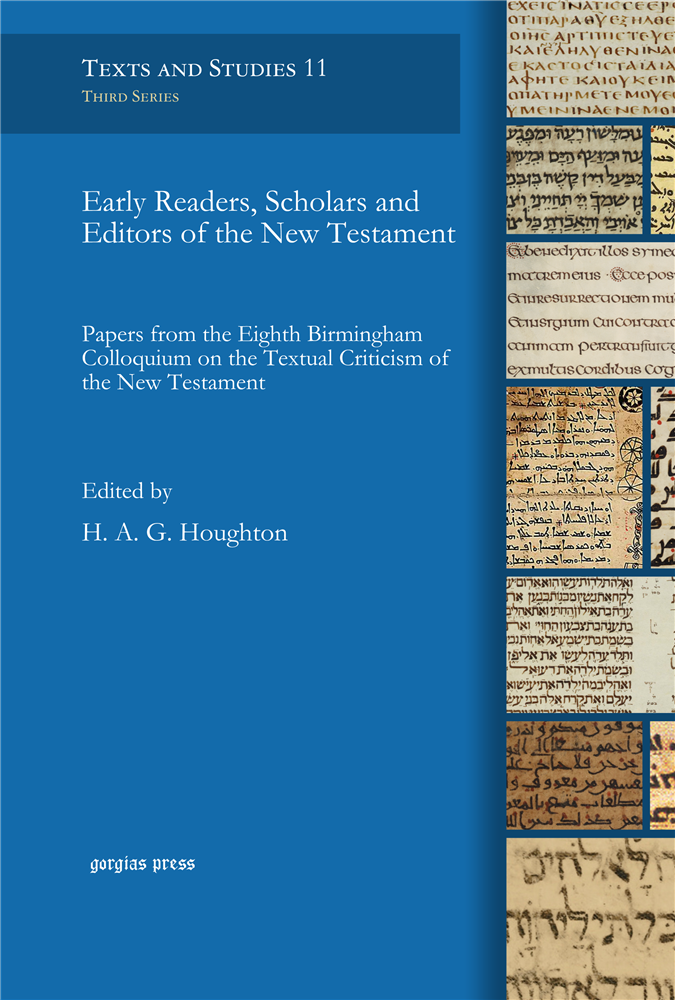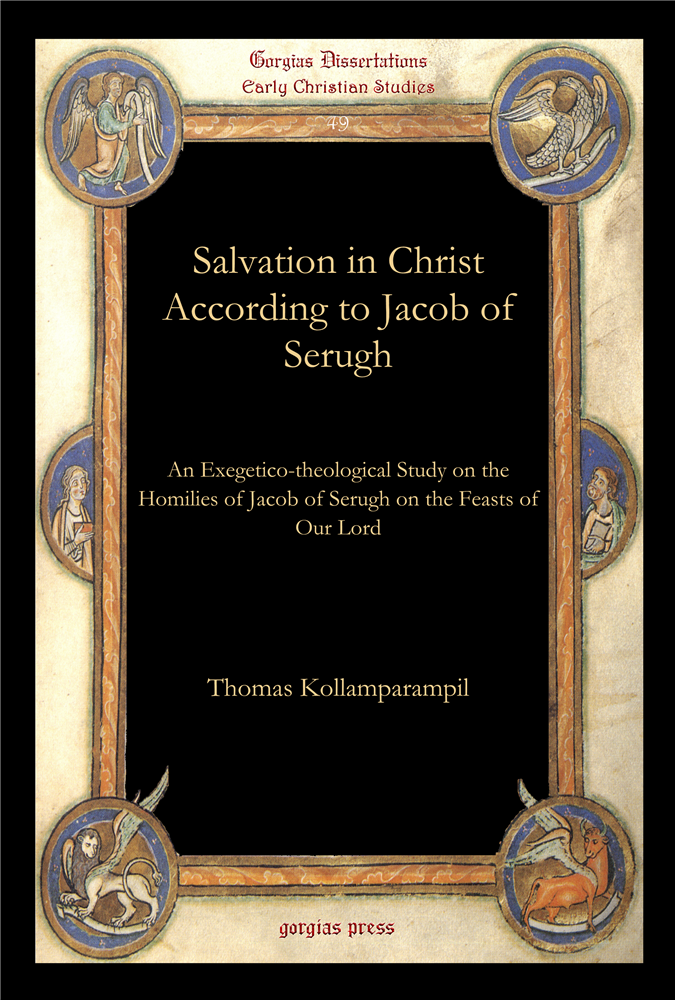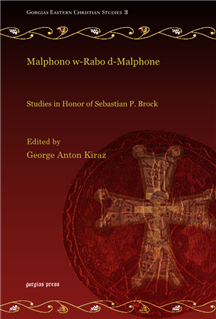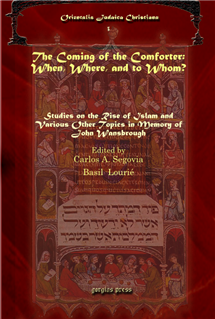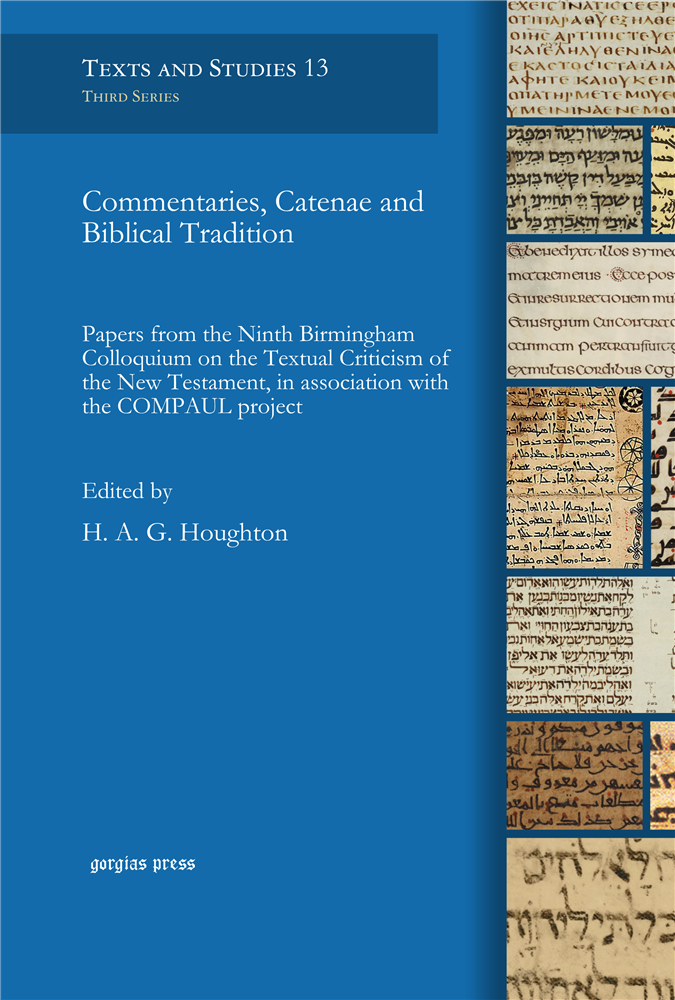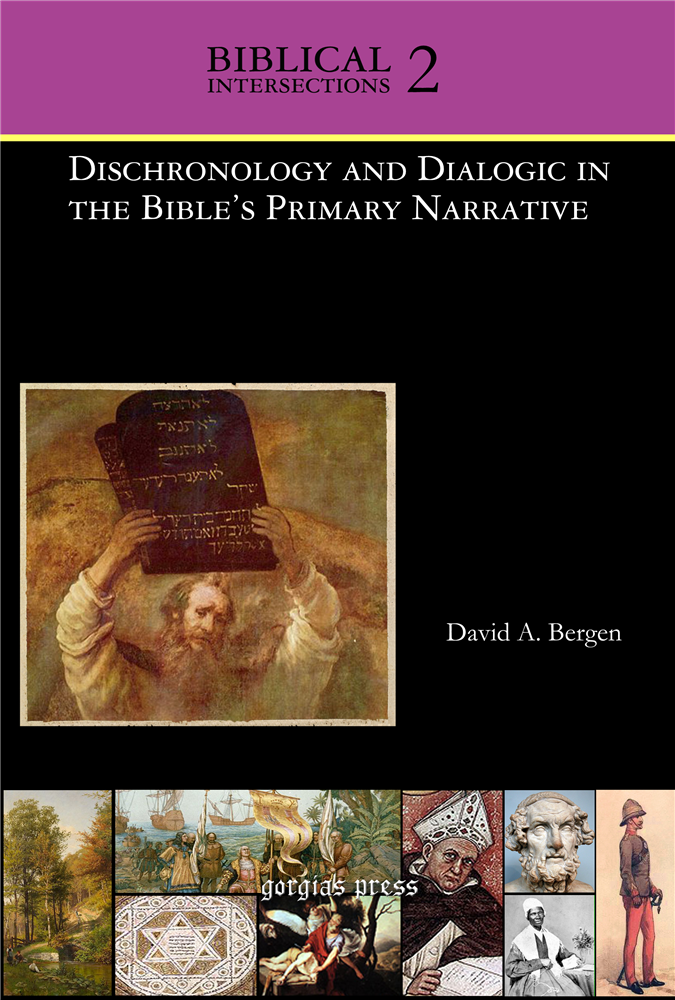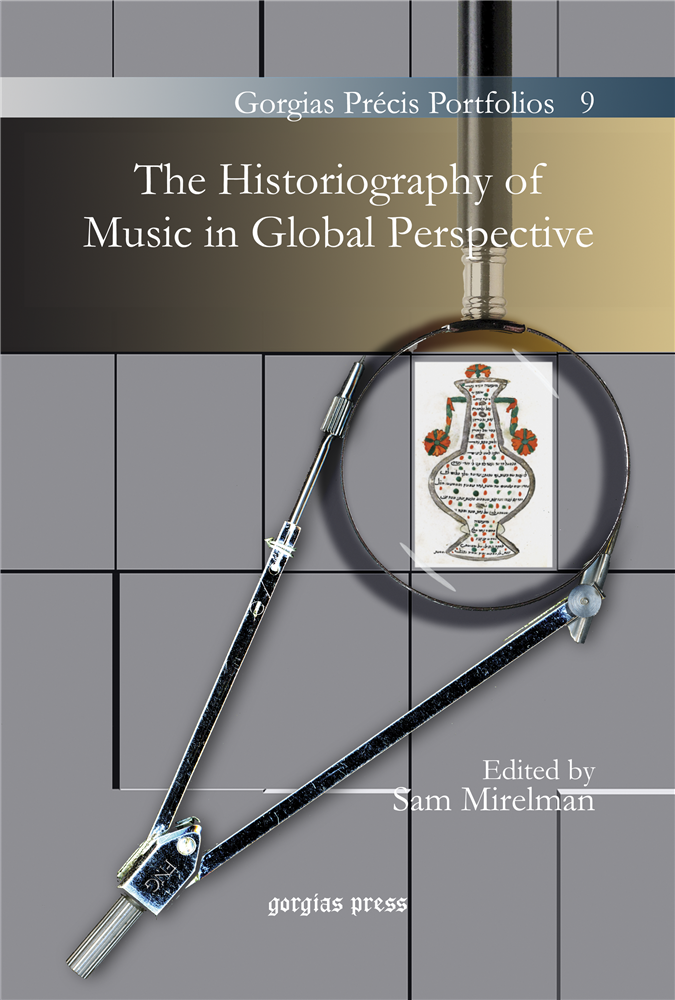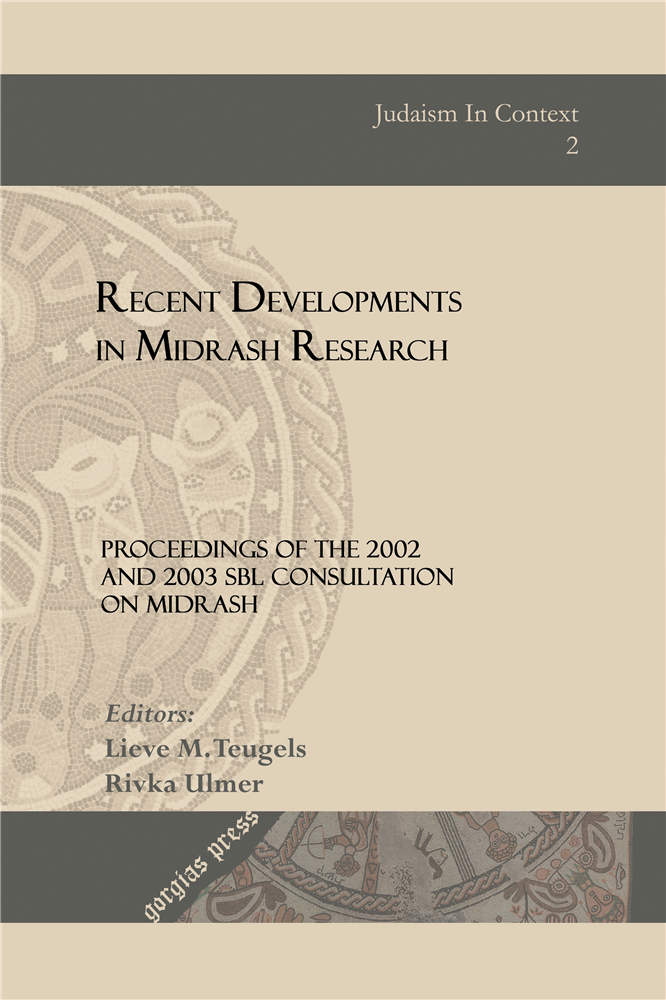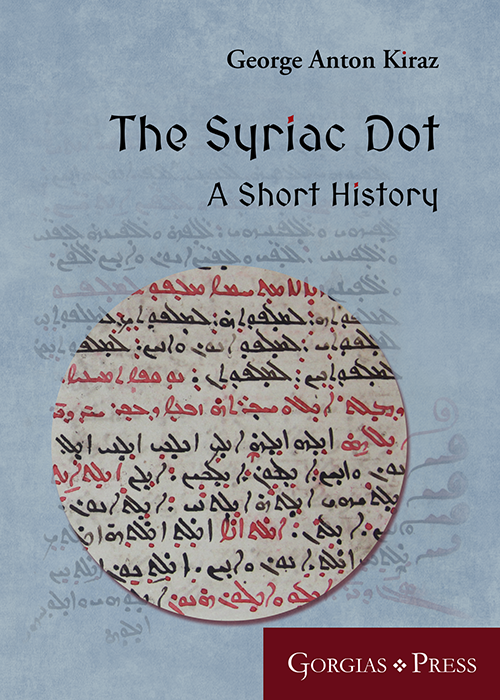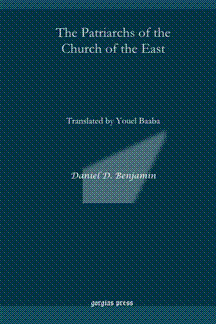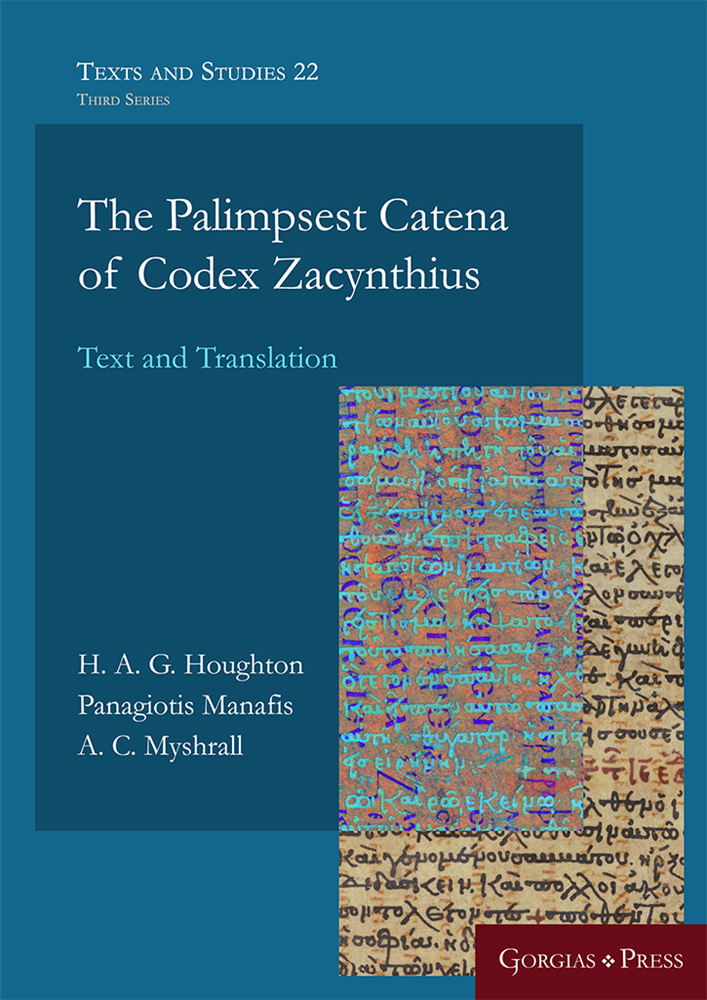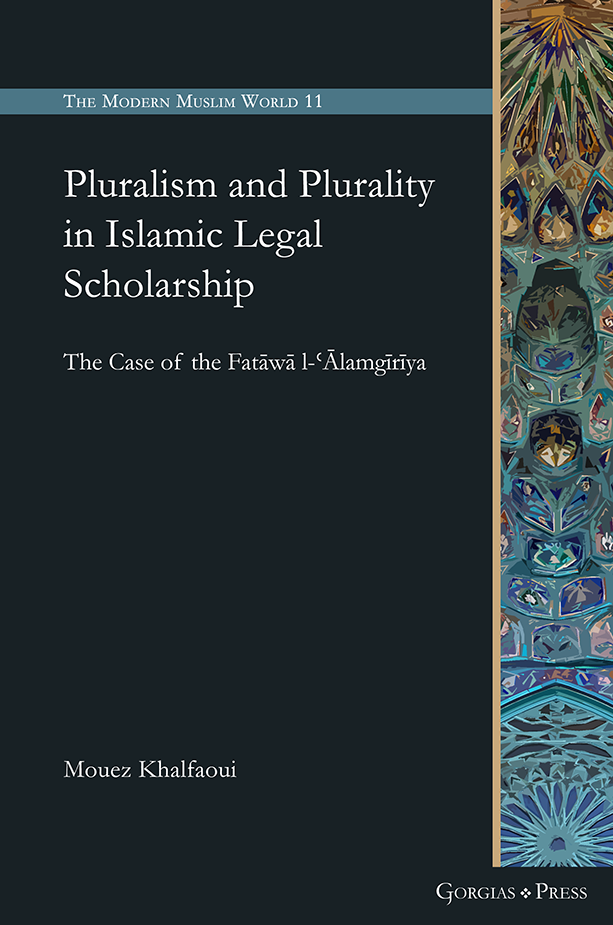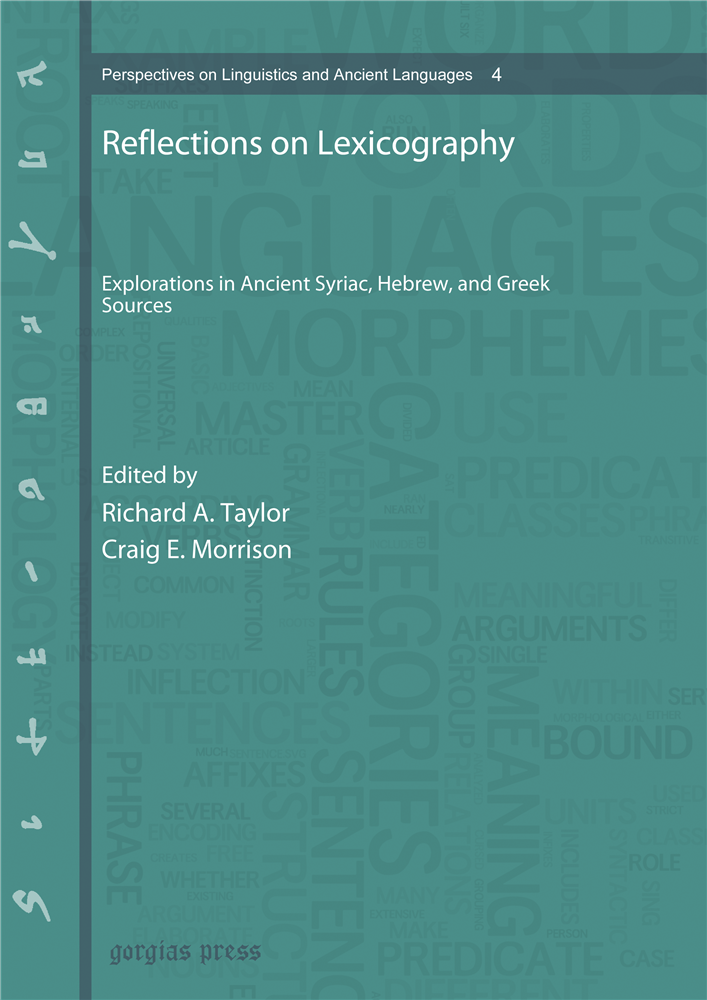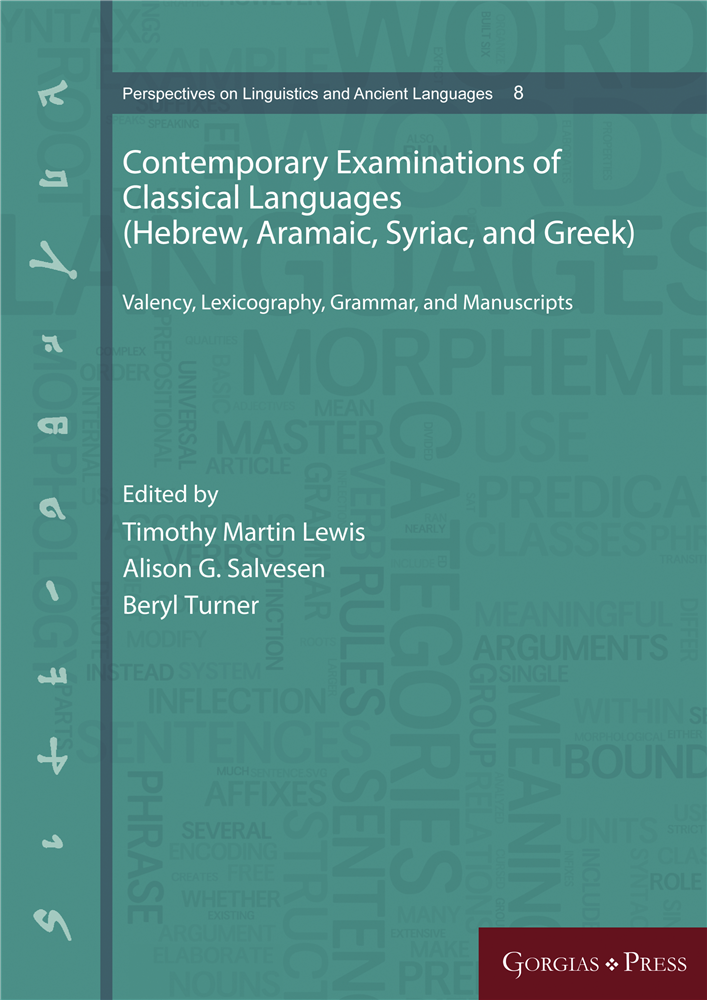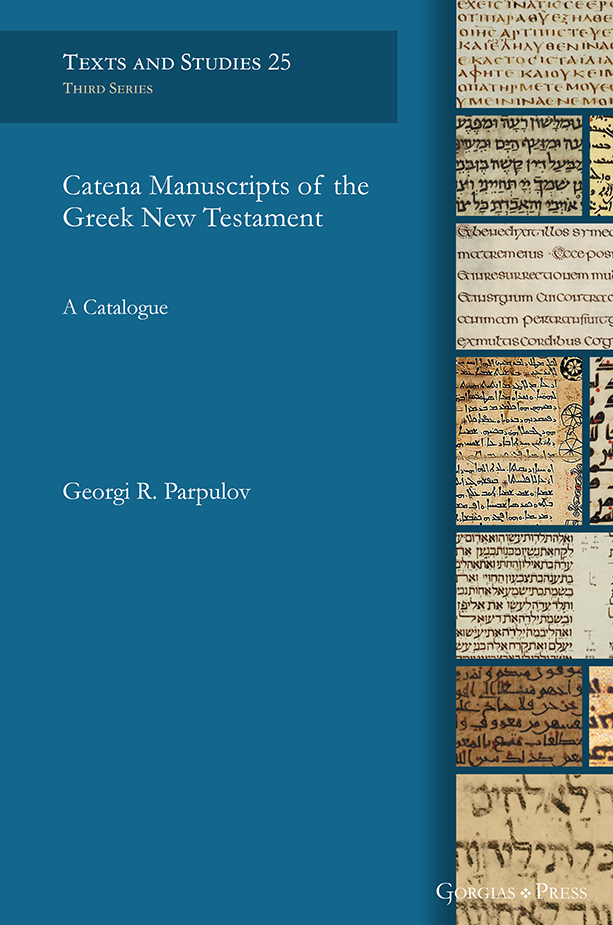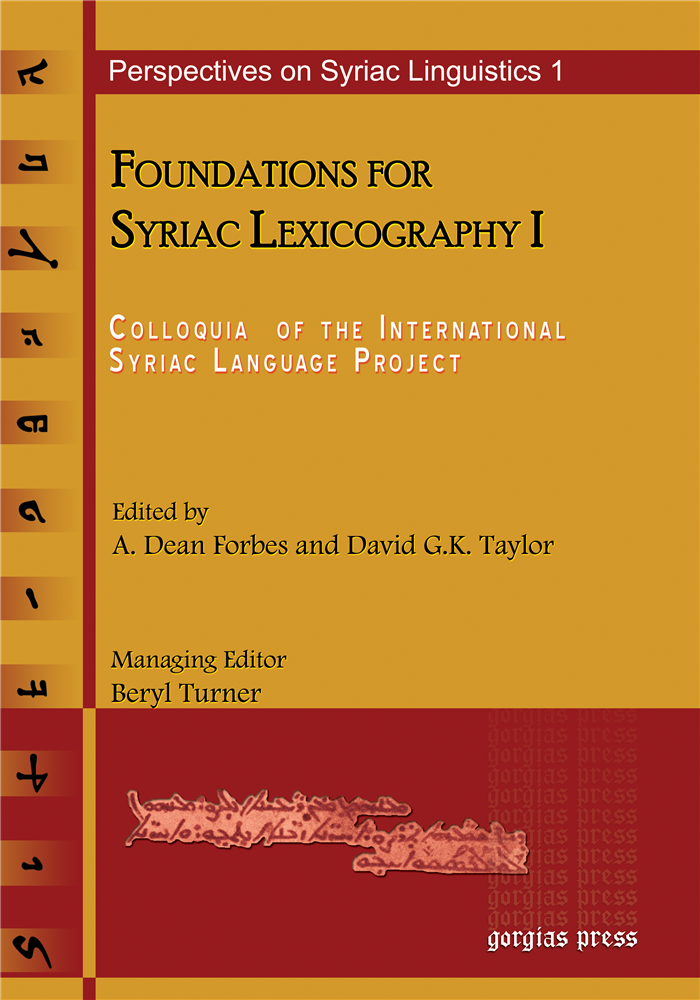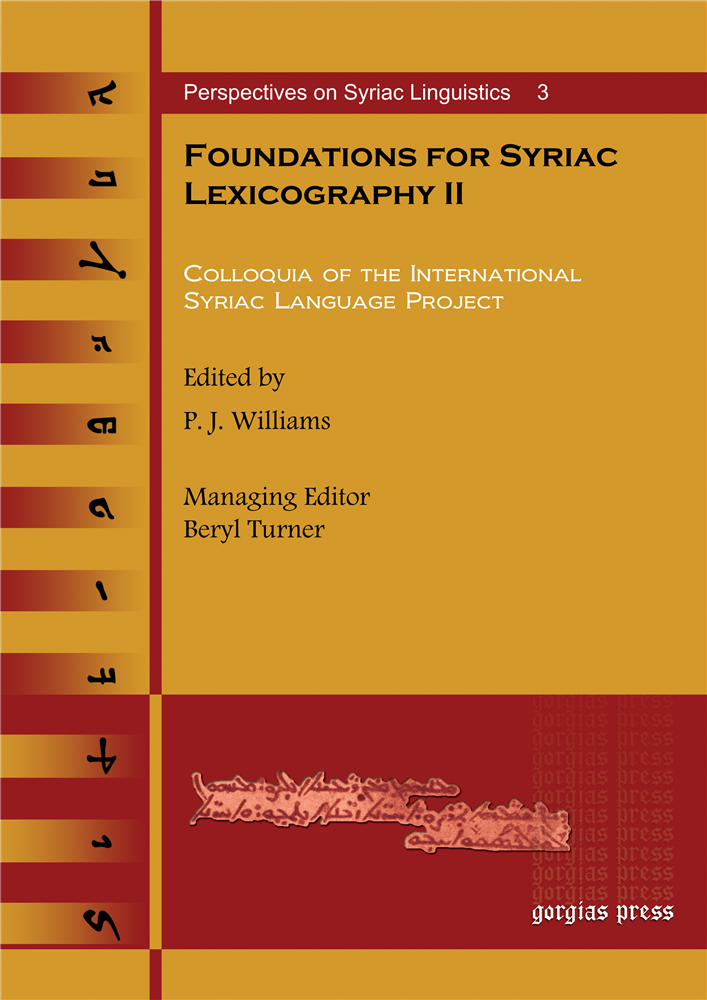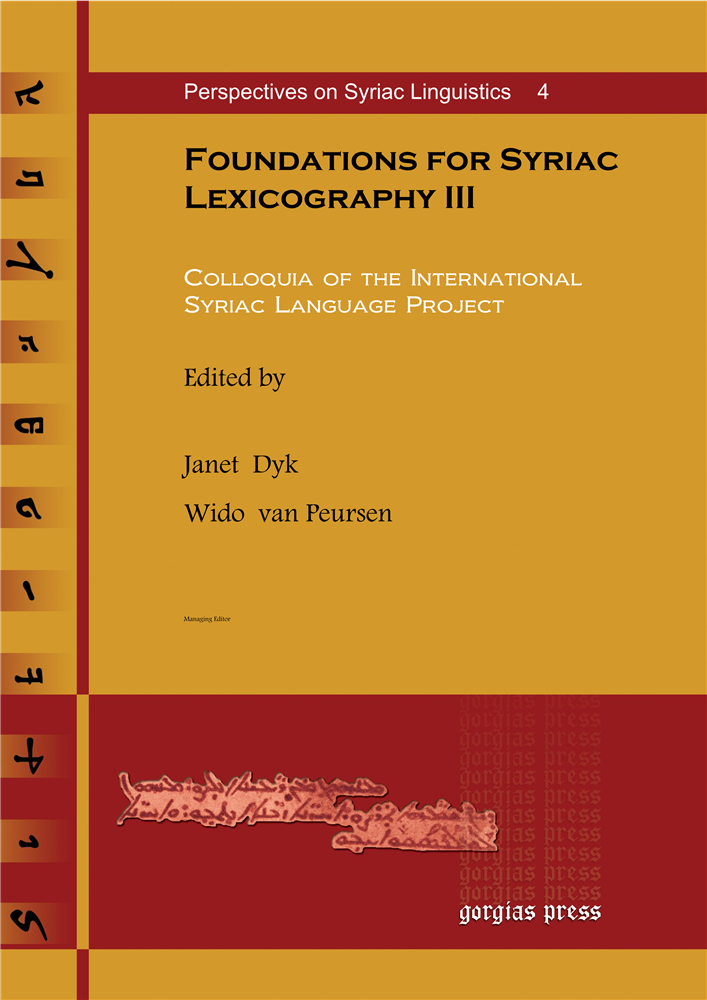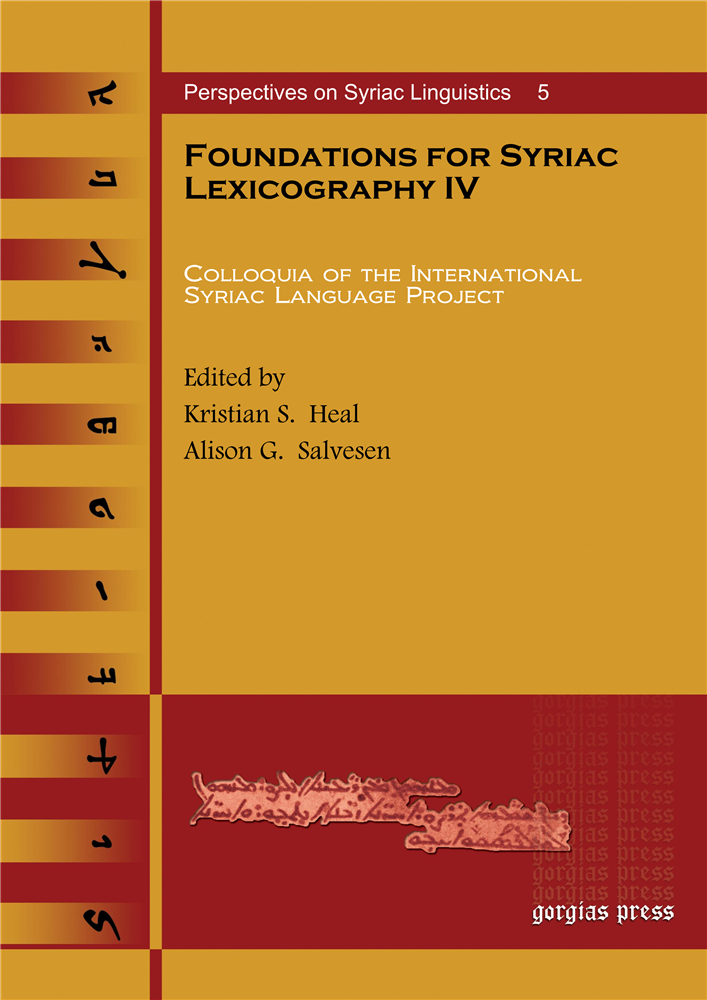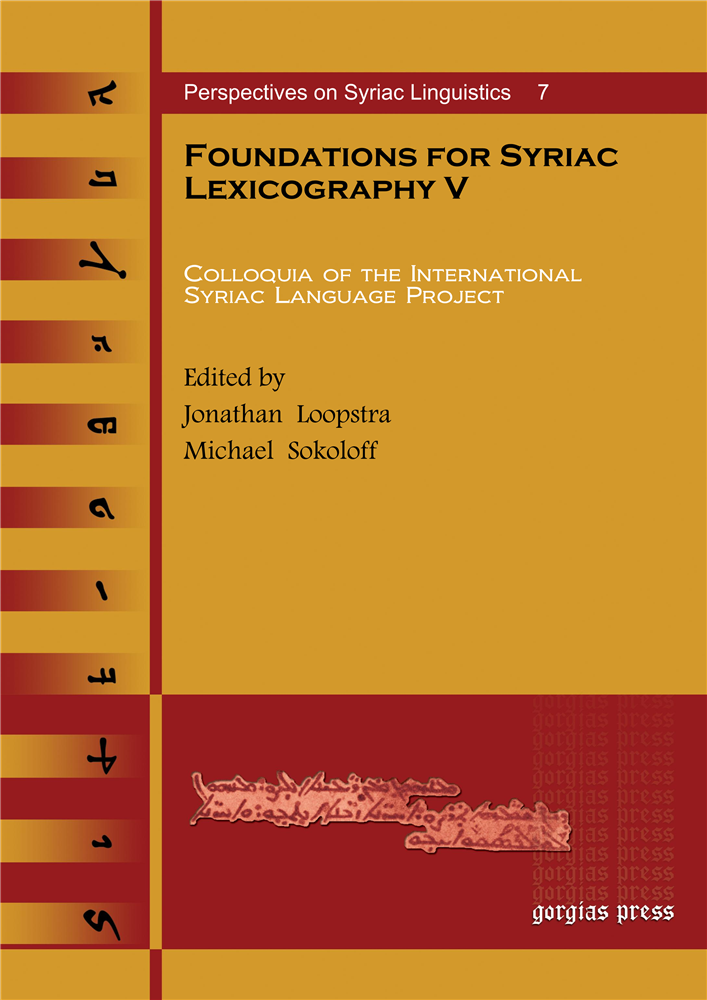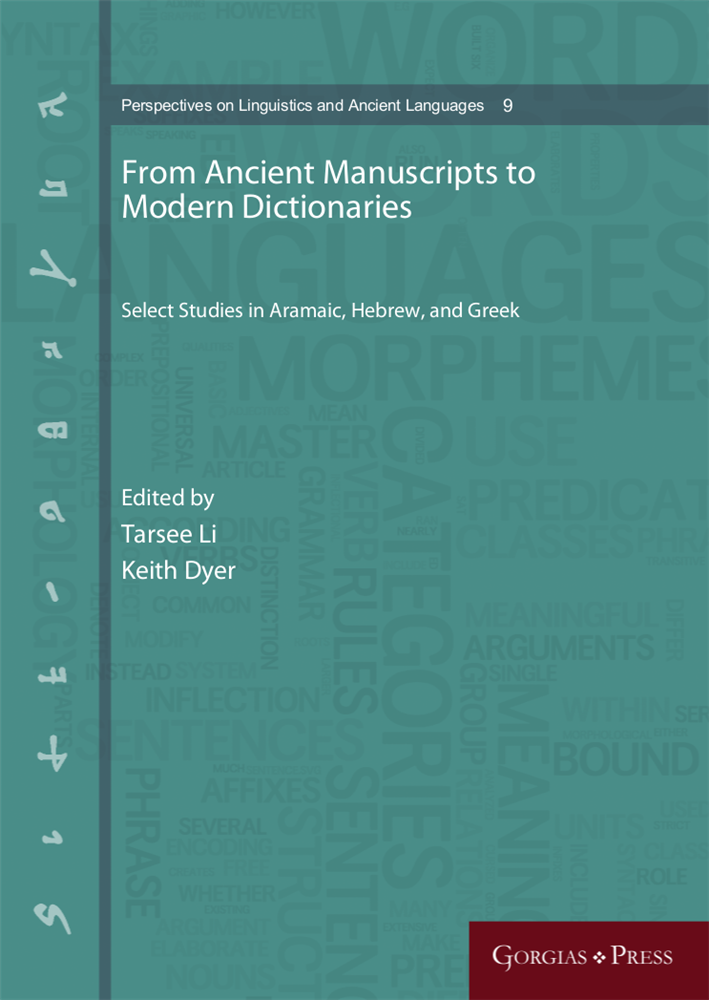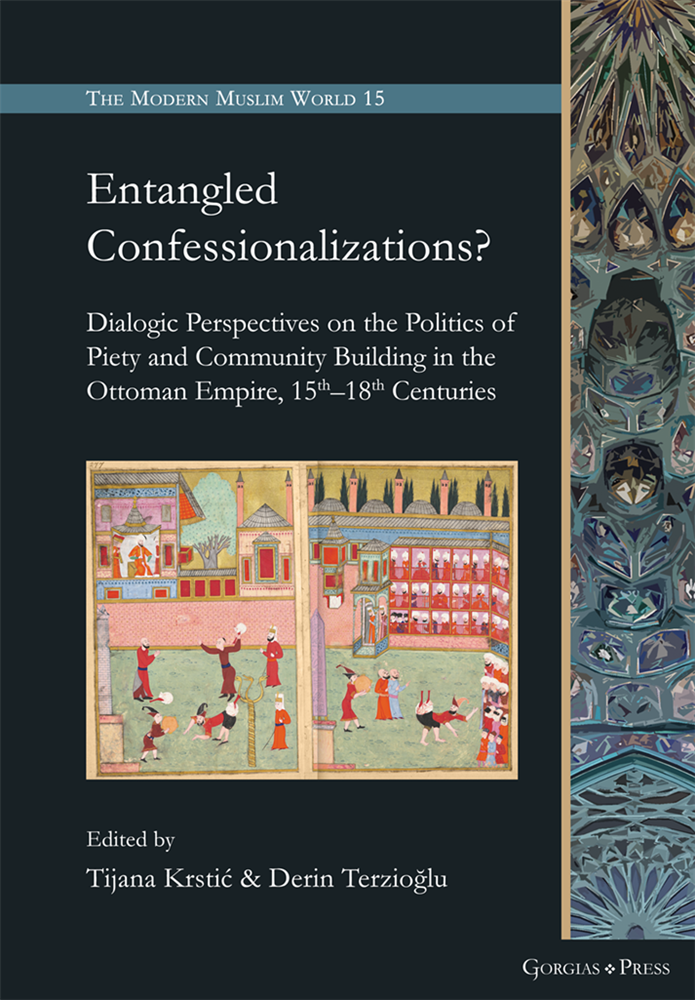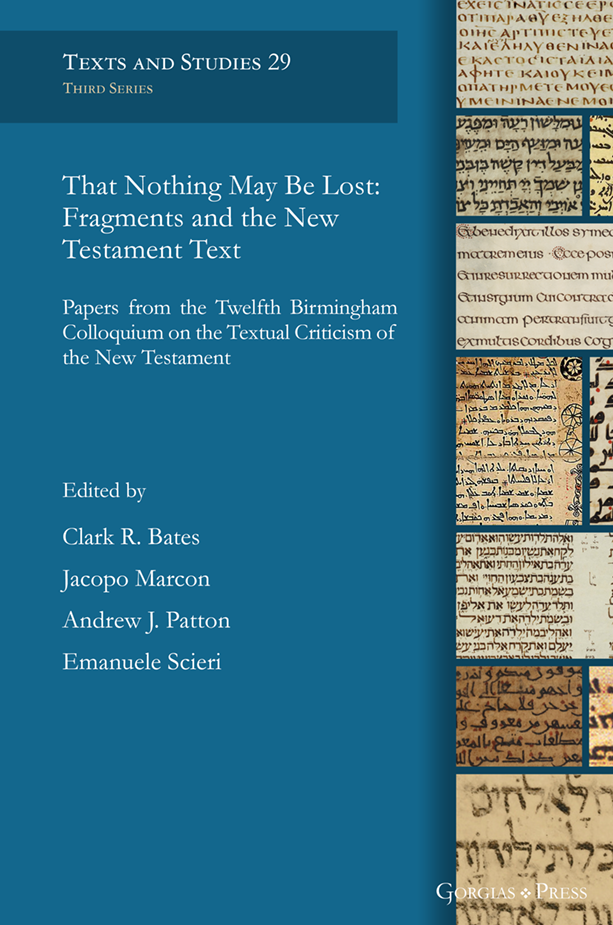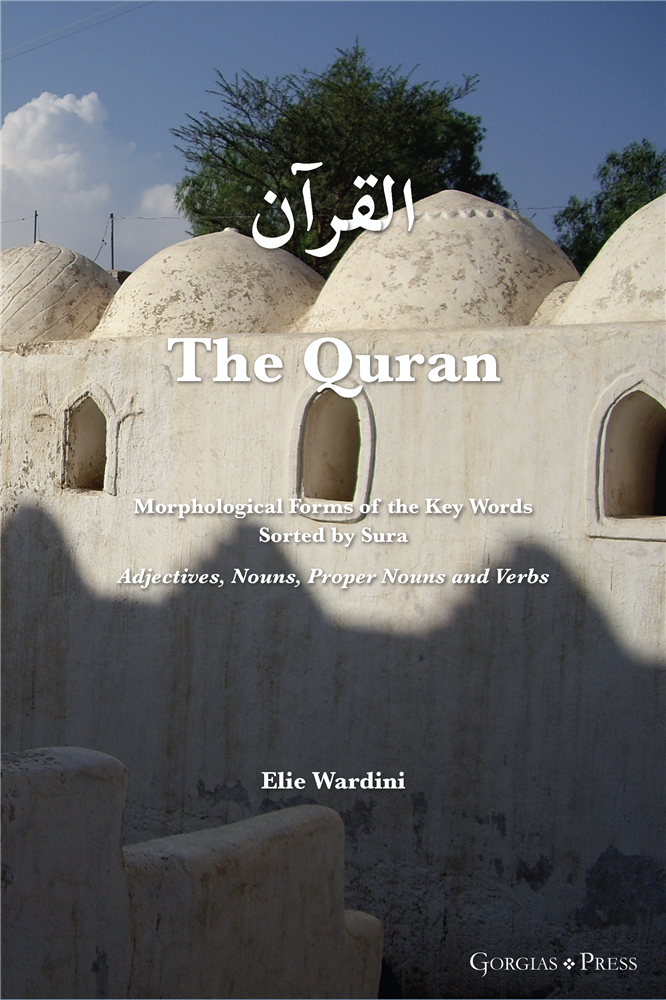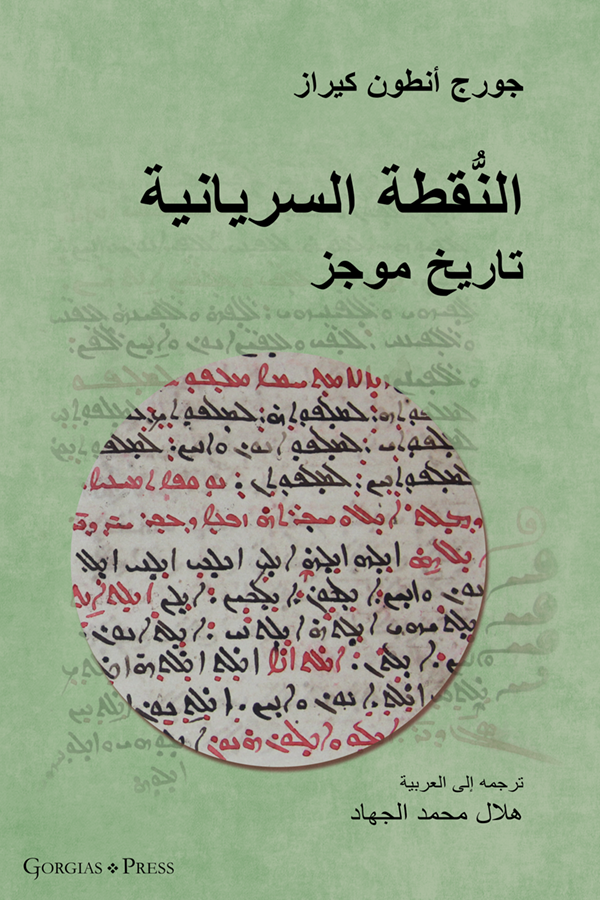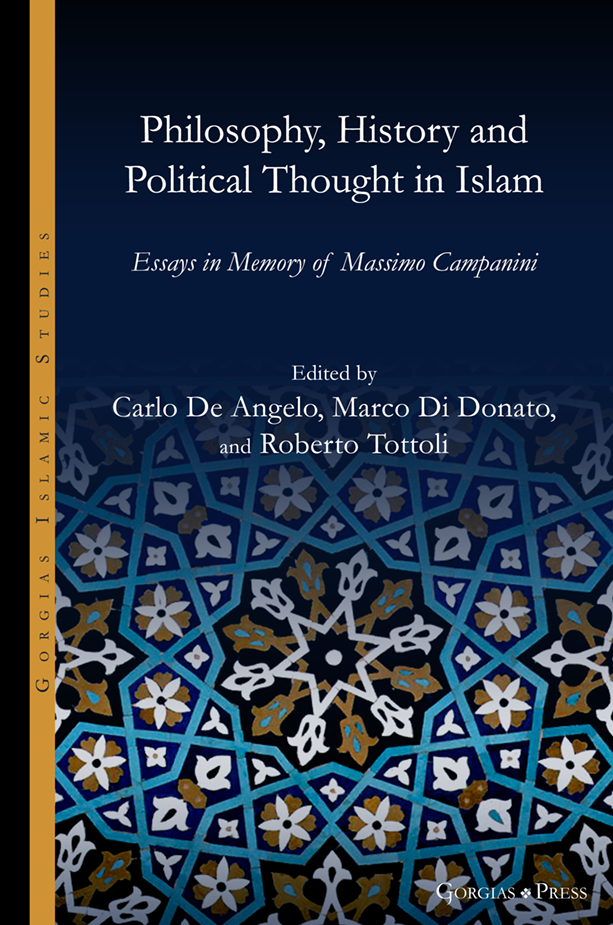Gorgias Open Repository
Early Readers, Scholars and Editors of the New Testament edited by H.A.G. Houghton | A collection of ten original papers on the New Testament text, first presented in 2013, which reflect the diversity of current research. Examples of ancient engagement with the Bible include Origen, Eusebius of Caesarea and Augustine along with early translations. | |
| Jacob of Serugh’s vision of ‘Salvation in Christ’, in its exegetical, theological, catechetical, liturgical and pastoral aspects, is reviewed in this monograph. Jacob’s mode of symbolic-mystical-silence approach to the mystery of Christ is explained. This treatise gathers up Jacob’s typological and symbolic thought-patterns, in his own language, categories, terminologies, and imageries. | |
"Some Lexical and Legal Notes on a Syriac Loan Transfer of 240 CE," |
| This article, drawn from Malphono w-Rabo d-Malphone, analyzes a Syriac legal document from the Upper Euphrates. Along with his analysis, Healey provides a translation and transliteration of the document. |
The Coming of the Comforter: When, Where, and to Whom? edited by Carlos A. Segovia and Basil Lourié |
| John Wansbrough is famous for his pioneering studies on the “sectarian milieu” out of which Islam emerged. In his view, Islam grew out of different - albeit rather marginal - Jewish and Christian traditions. In the present volume, which is dedicated to Wansbrough’s memory, specialists in Islamic studies and students of the Jewish and early Christian traditions summarise Wansbrough’s achievements in the past thirty years and chart the future of the tradition study of the “sectarian milieu.” |
Commentaries, Catenae and Biblical Tradition edited by H.A.G. Houghton |
| This collection of original research papers examines early commentaries on the New Testament and the transmission of the biblical text. Focussing principally on Greek and Latin tradition, it provides new insights into the sources and manuscripts of commentators and catenae. |
Dischronology and Dialogic in the Bible’s Primary Narrative
|
| This ground-breaking study offers a reassessment of Moses' book of the law from a narrative theory perspective. Concerned for the long-term viability of his people, Moses legislates a public reading of his document which is deposited next to the ark of the covenant as a national testament. Through the mechanics of narrative mediation, the narrator reveals to the reader of Deuteronomy the contents of Moses' enshrined publication. Deuteronomy's simulcast of Moses' book invites external readers to compare and evaluate their readings with story-world readers who access the same text within the Bible's Primary Narrative. |
The Historiography of Music in Global Perspective edited by Sam Mirelman
|
| This volume examines the perception of music’s past, in all its historical, geographical and cultural breadth. The wide-ranging collection of papers address the interpretation of past music cultures from the earliest records of antiquity until the present. |
Recent Developments in Midrash Research edited by Lieve Teugels and Rivka Ulmer |
| This work consists of a selection of papers from sessions during the first two years of SBL Consultation on Midrash. It demonstrates innovative approaches to midrashic texts and hermeneutic reflections on similarities and differences between interpretations of the Bible. |
|
The dot is used for everything in Syriac from tense to gender, number, and pronunciation, and unsurprisingly represents one of the biggest obstacles to learning the language. Using inscriptions, early grammars, and experiments with modern scribes, Dr. Kiraz peels back the evolution of the dot layer by layer to explain each of its uses in detail and to show how it adopted the wide range of uses it has today.
| |
The Patriarchs of the Church of the East |
| A comparative chronology of the Patriarchs of the Church of the East based on twenty-two sources, five of which are previously unpublished. Benjamin reveals a great number of differences between the sources and concludes that the present Patriarch of the Assyrian Church of the East was named Dinkha IV instead of Dinkha III. Benjamin also highlights inconsistencies, omissions, errors and dates of succession of some patriarchs that appear to have been based on assumption. The current volume, with carefully arranged tabular lists and comments, is essential to further research on the chronology of the Patriarchs of the Church of the East. The book is written in three languages: English, Syriac and Arabic. |
Codex Zacynthius: Catena, Palimpsest, Lectionary Edited by H. A. G. Houghton and David C. Parker |
| This book consists of a series of studies of Codex Zacynthius (Cambridge, University Library MS Add. 10062), the earliest surviving New Testament commentary manuscript in catena format. A research project funded by the UK Arts and Humanities Research Council has produced new multispectral images of the palimpsest undertext in order to enable a thorough investigation of the manuscript and the creation of a complete electronic edition. This volume, co-authored by the members of the project, will provide a full account of the research undertaken by the project. Many advances have resulted from this research, which will be presented here for the first time in print. |
| This book is the first-ever edition of the complete palimpsest undertext of Codex Zacynthius (Cambridge, University Library MS Add. 10062), the earliest surviving New Testament commentary manuscript in catena format. It relies on new multispectral images produced by a research project funded by the UK Arts and Humanities Research Council in 2018. | |
| This book presents the positions held by ḥanafite Muslim jurists in South Asia in the 17th century with regard to the coexistence of Muslims and non-Muslims, and, secondly, compares the opinions put forth by these South Asian jurists with those maintained by their counterparts in Central Asia and the Middle East. | |
Edited by Richard A. Taylor and Craig E. Morrison |
| Colloquia of the International Syriac Language Project. The essays collected in this volume probe various linguistic problems, analyze certain lexicographical methods, evaluate selected lexical tools currently available, and set forth descriptions and/or proposals for forthcoming lexical projects. The papers are organized into three groups, depending on their primary language orientation. The first group focuses on selected areas of lexicography for texts written in Classical Syriac. The second group deals with certain areas of semantics and lexicography for Biblical Hebrew. The third group treats aspects of lexical analysis for the Greek New Testament. The common thread that ties the essays together is a focus on lexicography. |
Contemporary Examinations of Classical Languages (Hebrew, Aramaic, Syriac, and Greek) Edited by Timothy Martin Lewis, Alison G. Salvesen & Beryl Turner | | Ancient language study is becoming an increasingly sophisticated and complex discipline, as scholars not only consider methods being used by specialists of other languages, but also absorb developments in other disciplines to facilitate their own research investigations. This interdisciplinary approach is reflected in the scope of research papers offered here, invited and peer-reviewed by the ISLP. The volume is presented in three parts. |
| The book is a synoptic catalogue of a large class of Greek manuscripts: it describes all pre-seventeenth century copies of the Greek New Testament in which the biblical text is accompanied by commentary. Manuscripts where this commentary consists of combined excerpts (catena) from the works of various authors are described in particular detail. Those that have similar content are grouped together, so that the potential relatives of any given manuscript can be easily identified. Several previously unknown types of catenae are distinguished and a number of previously unstudied codices are brought to light for the first time. To ensure its longer shelf-life, the volume systematically references on-line electronic databases (which are regularly updated). It will be of use to anyone interested in Byzantine book culture and in biblical exegesis. | |
Foundations for Syriac Lexicography I Edited by Dean Forbes & David G.K. Taylor |
| This volume is the first in a series that addresses issues of Syriac linguistics as they relate to a contemporary approach to lexicography. The international team of authors invited to participate represents a wide range of disciplines and opens new horizons in lexical thinking. In a substantial introductory essay, Terry Falla outlines a conceptual framework for a new comprehensive Syriac-English lexicon; Alison Salvesen looks at the user versus the lexicographer, and notes practical and scientific issues in creating lexical entries; George Kiraz presents the history of Syriac computational lexicography and points to the future of computing the Syriac lexicon; Dean Forbes’ ground-breaking work on computational analysis of the syntax of the Hebrew scriptures introduces a statistical approach to syntactical analysis; Janet Dyk outlines desiderata for the lexicon from a syntactic point of view; Peter Williams discusses how to match Syriac words with their Greek Vorlage; Andreas Juckel raises the question of whether the Harklean version should be included in a future lexicon of the Syriac New Testament; Sebastian Brock reflects on resources and sources of Syriac lexica. This book is at the forefront of Syriac lexical studies, and has much to offer those studying Greek and Semitic languages. |
Foundations for Syriac Lexicography II Edited by P. J. Williams; Managing Editor Beryl Turner |
| This volume is the second in a series that addresses issues related to a contemporary approach to Classical Syriac lexicography. The international team of authors invited to participate in this volume represents a wide range of disciplines and opens new horizons in lexical thinking. The essays of Dean Forbes and Janet Dyk break new ground in discussions of taxonomy and are of relevance to lexicographers of any language: Forbes applies computational methods of pattern recognition to word distribution in the Hebrew Bible and discusses its application to grammatical classification, and Dyk examines the form and functions of the Syriac passive participle. Peter Williams examines matters involved in translating Greek words with alpha privatives into Syriac. In a joint article Terry Falla and Wido van Peursen discuss the syntax and translation of two Syriac particles, ger and dyn. Andreas Juckel provides scholars for the first time with the text of the Harklean margin to the Corpus Paulinum along with a detailed analysis. George Kiraz and Bishop Polycarpus Augin Aydin provide important information on Syriac lexica from the East that deserve to be more widely known in the West: Kiraz examines the lexical and grammatical works of Audo, Manna, and David, and Aydin provides an English translation of the methodology that Manna used in compiling his lexicon. This book is at the forefront of Syriac lexical studies, and has much to offer those studying Greek and other Semitic languages as well. |
Foundations for Syriac Lexicography III Edited by Janet Dyk & Wido van Peursen; Managing Editor Beryl Turner | | This volume is the third in a series that addresses issues related to a contemporary approach to Classical Syriac lexicography. The international team of authors invited to participate in this volume represents a wide range of disciplines in Syriac, Greek and Hebrew linguistics, and opens new horizons in lexical thinking. Volume editors Janet Dyk and Wido van Peursen present the papers in four thematically related parts. Part 1: Lexicography and Morphology. Dirk Bakker argues for providing full information as to the identity of a lexeme; Percy van Keulen discusses derivation and inflection with regard to feminine nominal endings; Wido van Peursen deals with verbs beginning with ša; and Constantijn Sikkel argues for the inclusion of enclitics. Part 2: Lexicography and Syntax: Part of Speech Attribution. Terry Falla and Dean Forbes address grammatical classification in Syriac and Hebrew respectively. Part 3: Words, Texts, and Contexts. Janet Dyk examines translation choices made in Peshitta Kings; James Aitken looks at socio-historical background in Greek lexicographical work; and Reinier de Blois presents new tools and methodologies for the development of an electronic Hebrew lexicon. Part 4: Interdisciplinary Perspectives: Hebrew and Greek Lexicography. Regine Hunziker-Rodewald> details the Gesenius–BDB family of lexica and the KAHAL–HALAT project; Jo-Ann Hackett> and John Huehnergard report on revising and updating BDB; John Kaltner examines the Koehler–Baumgartner family; James Aitken examines the lexica of Zorell and Alonso Schoekel; and finally Reinier de Blois evaluates Louw and Nida’s approach to semantic domains from a cognitive linguistic perspective. |
Foundations for Syriac Lexicography IV Edited by Kristian S. Heal and Alison G. Salvesen |
| Lexicography is necessarily both a solitary and a collaborative business. The actual work of writing a lexicon advances only through the solitary efforts of the lexicographer, even when working in a team. However, the decisions that are made, and the insights derived from this process result from and contribute to a larger conversation with the lexicographical community. One subset of this community has organized itself around the International Syriac Language Project (ISLP), and this volume, with one exception, contains papers originally presented at the 2007 and 2008 annual meetings of this research group. The papers from these two meetings provide an opportunity to reflect on general issues, dive into specific case studies and consider the benefits of comparative analysis—a salutary telescopic collection generating both perspective and concrete data for the lexicographical enterprise. This volume is the fourth published colloquia of the International Syriac Language Project (ISLP). In this volume, editors Kristian Heal and Alison Salvesen present papers from an international team of authors working to develop contemporary, interdisciplinary approaches to linguistics and lexicography. This volume includes articles by Frederick William Danker, Terry C. Falla, Jonathan Loopstra, Wido van Peursen and Dirk Bakker, Beryl Turner, Craig E. Morrison (O. Carm), Paul S. Stevenson, Percy S. F. van Keulen, and Janet Dyk, bringing together the latest research in Syriac linguistics and lexicography in a way that would also benefit those working in Greek and other Semitic languages. |
Foundations for Syriac Lexicography V Edited by Jonathan Loopstra and Michael Sokoloff |
| The fifth published colloquia of the International Syriac Language Project (ISLP), presenting papers from an international team of authors working to develop contemporary, interdisciplinary approaches to linguistics and lexicography. Reinier de Blois proposes innovative ways that the discipline of cognitive linguistics can be used to help lexicographers determine the meaning of words. Marie-Louis Craig reviews the methodologies and motivations behind several early English lexicographers of Hebrew. Janet Dyk compares the Masoretic and Peshitta versions of Psalm 25. Marketta Liljestrom discusses the Syrohexapla as a source for lexicographers. Craig Morrison provides a detailed study of hwā qātel and hwā qĕtīl constructions in the Peshitta Old Testament. Paul Stevenson offers a test case for semantic componential analysis in his second study of the motion verbs in the Peshitta of Exodus, chapters 1–19. And Beryl Turner provides a methodological study of the preposition lwāt in preparation for the creation of a new Syriac-English dictionary. This volume brings together the latest research in Syriac linguistics and lexicography in a way that would also benefit those working in Greek and other Semitic languages. |
by Naomi Graetz |
| A contemporaneous and religiously meaningful retelling of biblical stories by a feminist who looks at intimate lives of people inhabiting the Bible. She rediscovers a past in which biblical women actively participated and suggests women’s leadership might lead to a better world. |
by Naomi Graetz |
| A stirring collection of fifteen articles, many of which have been previously published by the author who is a feminist Jew. The author unabashedly confronts difficult biblical and midrashic texts, without taking an apologetic stance. |
From Ancient Manuscripts to Modern Dictionaries Edited by Tarsee Li & Keith Dyer |
| These articles on Aramaic, Hebrew, and Greek lexicography have arisen from papers presented at the International Syriac Language Project's 14th International Conference in St. Petersburg in 2014. |
Entangled Confessionalizations? Edited by Tijana Krstić & Derin Terzioğlu |
| This volume explores the emergence of discourses of orthodoxy and orthopraxy in the Ottoman Empire between the 15th and 18th centuries, through empirical studies on confessional dynamics in early modern Muslim, Christian and Jewish sources. |
Edited by Clark R. Bates, Jacopo Marcon, Andrew J. Patton & Emanuele Scieri |
| Fragmentary material comprises a significant part of the manuscript tradition of the New Testament. Whether it be tattered papyrus documents, the abbreviated citation of biblical texts in early Christian writings, or the scattering of once-whole manuscripts, the story of the New Testament is a gathering of fragments—in all their forms—in the hopes that “nothing may be lost.” This volume is a result of the Twelfth Birmingham Colloquium on the Textual Criticism of the New Testament, wherein presenters were invited to approach the theme of “fragments” from any philological or philosophical framework. Chapters discuss the possible forgery of a biblical papyrus, the dismemberment of a sixteenth-century lectionary manuscript, and the Arabic text of Romans preserved in a fragmentary bilingual codex. Elsewhere, software tools are employed to re-assess the readings of manuscripts digitised in decades past and to re-evaluate the stemma of a family of manuscripts. Further contributions consider the fragments of the biblical text contained in patristic commentaries and Byzantine catenae. The wide-ranging scope of the research contained in this volume reflects the need to examine these pieces of the past so that the shape of research in the present accurately illustrates the tapestry that is the history of the New Testament texts. |
The Quran. Morphological Forms of the Key Words Sorted by Sura By Elie Wardini |
| The aim with the present book, Morphological Forms of the Key Words Sorted by Sura, is to present every morphological form of each Key Word, here adjectives, nouns, proper nouns and verbs, attested in the Quran sorted by sura. The digital text used for this purpose is the Uthmani text of the Tanzil Quran Text. This text is widely used, and we have conducted some comparison to pre-digital age printed editions of the Quran. All vocalized Arabic text is quoted unaltered in any shape or form from the Tanzil text. Unvocalized Arabic text and transcriptions are my own. The Key Words are always referenced by their lemma and are sorted alphabetically according to Arabic and UNICODE order with minor adjustments for consistency. In lemmatizing the words, no attention has been given to the semantics of each word. Only on rare occasion have similar forms of words or proper nouns been separated in order to avoid confusion. |
The Syriac Dot / النُّقطة السريانية (Arabic Edition) By George Anton Kiraz; Translated by Hilal Mohammad Al-Jihad |
| |
Edited by George Anton Kiraz & Sabine Schmidtke | The colophon, the ultimate or “crowing touch” paragraphs of a manuscript or a book, provides readers with a the historical context in which the scribe produced the manuscript (or the publisher, a book). At its most fundamental level, the colophon gives us the “metadata” of the manuscript: who was the scribe? When and where was the manuscript produced? For whom was it produced and who paid for it? But colophons are far more rich. They are literary works in their own right, having a style and rhetoric independent of the main literary text of the manuscript. Some are assertive, providing contextual data about the scribe/publisher and manuscript/book; others are expressive, demonstrating the scribe’s feelings and wishes. Some are directive, asking the reader for an action; others declarative, providing all sorts of statements about the scribe/publisher or even the reader. The latter sometimes provide historical facts otherwise lost to histories: wars, earthquakes, religious events, legal agreements, etc. This edited volume brings together scholars from various disciplines to study colophons in various languages and traditions across space and time. | |
Article: Reflections Of An Early Egyptian Feminist In A Changing World: Malak Ḥifnī Nāṣif’s Positions On Women’s Wage Labour by Serena Tolino From the book: Philosophy, History and Political Thought in Islam: Essays in Memory of Massimo Campanini |
| This chapter focuses on the intersection of gender and labour history, reflecting on how early feminist sources can contribute to our understanding of labour in the Middle East. It does so by focusing on a speech by Malak Ḥifnī Nāṣif (1886-1918) on women's wage labour. The chapter begins with an overview of existing scholarship on gender and labour history in the Middle East, with a particular focus on Egypt. It then focuses on the life of Malak Ḥifnī Nāṣif before moving on to the specific speech that allows for an in-depth exploration of her approach to women’s wage labour. By analysing her perspective, the chapter represents a first step in bridging the gap between feminist sources and labour history. |

All works in the Gorgias Open Repository are licensed under a Creative Commons Attribution-NonCommercial 4.0 International License.

